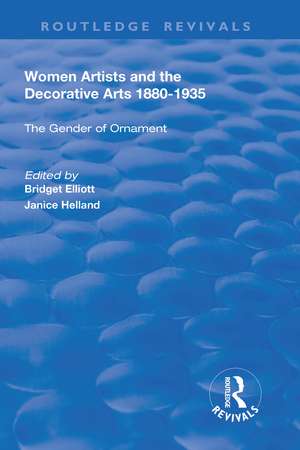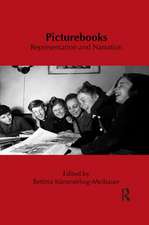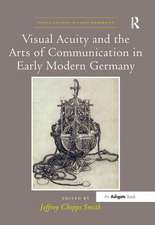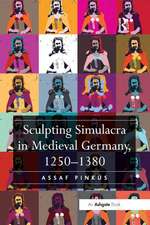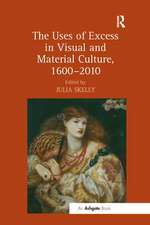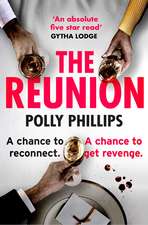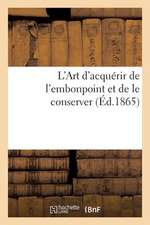Women Artists and the Decorative Arts 1880-1935: The Gender of Ornament: Routledge Revivals
Editat de Bridget Elliott, Janice Hellanden Limba Engleză Hardback – 28 iun 2018
Din seria Routledge Revivals
- 9%
 Preț: 801.69 lei
Preț: 801.69 lei - 8%
 Preț: 432.15 lei
Preț: 432.15 lei -
 Preț: 153.81 lei
Preț: 153.81 lei -
 Preț: 230.80 lei
Preț: 230.80 lei -
 Preț: 294.72 lei
Preț: 294.72 lei -
 Preț: 258.72 lei
Preț: 258.72 lei - 9%
 Preț: 764.34 lei
Preț: 764.34 lei - 9%
 Preț: 903.41 lei
Preț: 903.41 lei -
 Preț: 296.10 lei
Preț: 296.10 lei -
 Preț: 342.36 lei
Preț: 342.36 lei - 9%
 Preț: 606.35 lei
Preț: 606.35 lei -
 Preț: 317.54 lei
Preț: 317.54 lei - 9%
 Preț: 764.28 lei
Preț: 764.28 lei -
 Preț: 257.00 lei
Preț: 257.00 lei -
 Preț: 238.40 lei
Preț: 238.40 lei -
 Preț: 259.47 lei
Preț: 259.47 lei - 9%
 Preț: 903.80 lei
Preț: 903.80 lei -
 Preț: 326.26 lei
Preț: 326.26 lei -
 Preț: 258.66 lei
Preț: 258.66 lei -
 Preț: 294.97 lei
Preț: 294.97 lei -
 Preț: 308.89 lei
Preț: 308.89 lei -
 Preț: 199.85 lei
Preț: 199.85 lei -
 Preț: 347.49 lei
Preț: 347.49 lei -
 Preț: 295.04 lei
Preț: 295.04 lei -
 Preț: 389.39 lei
Preț: 389.39 lei -
 Preț: 257.00 lei
Preț: 257.00 lei -
 Preț: 343.21 lei
Preț: 343.21 lei - 9%
 Preț: 640.90 lei
Preț: 640.90 lei - 9%
 Preț: 619.48 lei
Preț: 619.48 lei -
 Preț: 228.88 lei
Preț: 228.88 lei -
 Preț: 257.67 lei
Preț: 257.67 lei -
 Preț: 245.10 lei
Preț: 245.10 lei -
 Preț: 258.52 lei
Preț: 258.52 lei -
 Preț: 258.72 lei
Preț: 258.72 lei -
 Preț: 368.93 lei
Preț: 368.93 lei -
 Preț: 246.37 lei
Preț: 246.37 lei - 9%
 Preț: 832.07 lei
Preț: 832.07 lei -
 Preț: 258.66 lei
Preț: 258.66 lei -
 Preț: 286.98 lei
Preț: 286.98 lei - 18%
 Preț: 695.85 lei
Preț: 695.85 lei - 9%
 Preț: 934.94 lei
Preț: 934.94 lei - 5%
 Preț: 231.22 lei
Preț: 231.22 lei -
 Preț: 267.15 lei
Preț: 267.15 lei -
 Preț: 200.66 lei
Preț: 200.66 lei - 9%
 Preț: 638.61 lei
Preț: 638.61 lei -
 Preț: 259.68 lei
Preț: 259.68 lei - 9%
 Preț: 1038.45 lei
Preț: 1038.45 lei -
 Preț: 389.43 lei
Preț: 389.43 lei -
 Preț: 302.13 lei
Preț: 302.13 lei -
 Preț: 294.72 lei
Preț: 294.72 lei
Preț: 708.55 lei
Preț vechi: 989.73 lei
-28% Nou
Puncte Express: 1063
Preț estimativ în valută:
135.58€ • 141.56$ • 112.21£
135.58€ • 141.56$ • 112.21£
Carte tipărită la comandă
Livrare economică 05-19 aprilie
Preluare comenzi: 021 569.72.76
Specificații
ISBN-13: 9781138721456
ISBN-10: 113872145X
Pagini: 244
Dimensiuni: 156 x 234 x 21 mm
Greutate: 0.45 kg
Ediția:1
Editura: Taylor & Francis
Colecția Routledge
Seria Routledge Revivals
Locul publicării:Oxford, United Kingdom
ISBN-10: 113872145X
Pagini: 244
Dimensiuni: 156 x 234 x 21 mm
Greutate: 0.45 kg
Ediția:1
Editura: Taylor & Francis
Colecția Routledge
Seria Routledge Revivals
Locul publicării:Oxford, United Kingdom
Cuprins
Contents: Introduction, Bridget Elliott and Janice Helland; Patterns of life: The art and design of Phoebe Anna Traquair and Mary Seton Watts, Elizabeth Cumming; May Morris: ubiquitous, invisible arts and craftswoman, Jan Marsh; The decorated object: gender, modernism and the design of industrial ceramics in Britain in the 1930s, Cheryl Buckley; Owning femininity: Thea Proctor and the Australian avant-garde, Pamela Gerrish Nunn; The performative art of court dress, Janice Helland; 'She would not cook the spaghetti...': domestic and decorative femininity and the film designs of Natacha Rambova, Jennifer Cottrill; Laura Nagy: Magyár Muse, Sandra Alfoldy; Engendering the spaces of modernity: The Women's Exhibition, Amsterdam 1913, Jane Beckett; Housing the work: women artists, modernism and the maison d'artiste: Eileen Gray, Romaine Brooks and Gluck, Bridget Elliott; Crystal flowers, pink candy hearts, and tinsel creation: The subversive femininity of Florine Stettheimer, Barbara J. Bloemink; Index.
Notă biografică
Janice Helland, Bridget Elliott
Recenzii
'... a theoretically sound overview of the gendering of decoration... a timely addition to scholarship in the area of decorative arts... a valuable reference source for those interested in Modernism across the fields of architecture, design and fine arts...'
- Ailsa Boyd, Journal of the Scottish Society for Art History
'... a stimulating approach to a study of women's role, and their achievements, in the decorative arts... It is a pleasure to see such a refeshing and well-researched study, encompassing such a range of designers and makers and variety of art forms.'
- The Journal of William Morris Studies
- Ailsa Boyd, Journal of the Scottish Society for Art History
'... a stimulating approach to a study of women's role, and their achievements, in the decorative arts... It is a pleasure to see such a refeshing and well-researched study, encompassing such a range of designers and makers and variety of art forms.'
- The Journal of William Morris Studies
Descriere
This title was first published in 2002. To date, studies explaining decorative practice in the early modernist period have largely overlooked the work of women artists. For the most part, studies have focused on the denigration of decorative work by leading male artists, frequently dismissed as fashionably feminine. With few exceptions, women have been cast as consumers rather than producers. The first book to examine the decorative strategies of late nineteenth- and early twentieth-century women artists, Women Artists and the Decorative Arts concentrates in particular on women artists who turned to fashion, interior design and artisanal production as ways of critically engaging various aspects of modernity.
